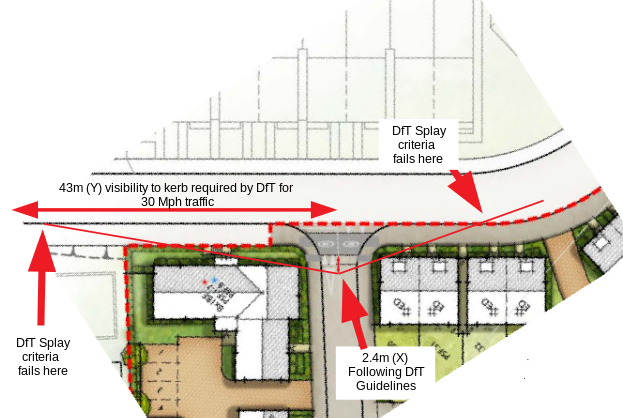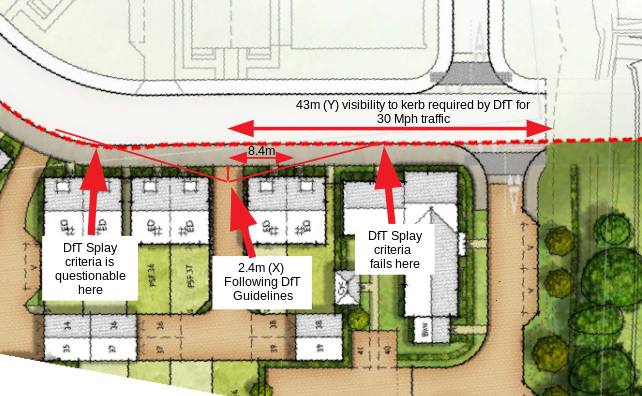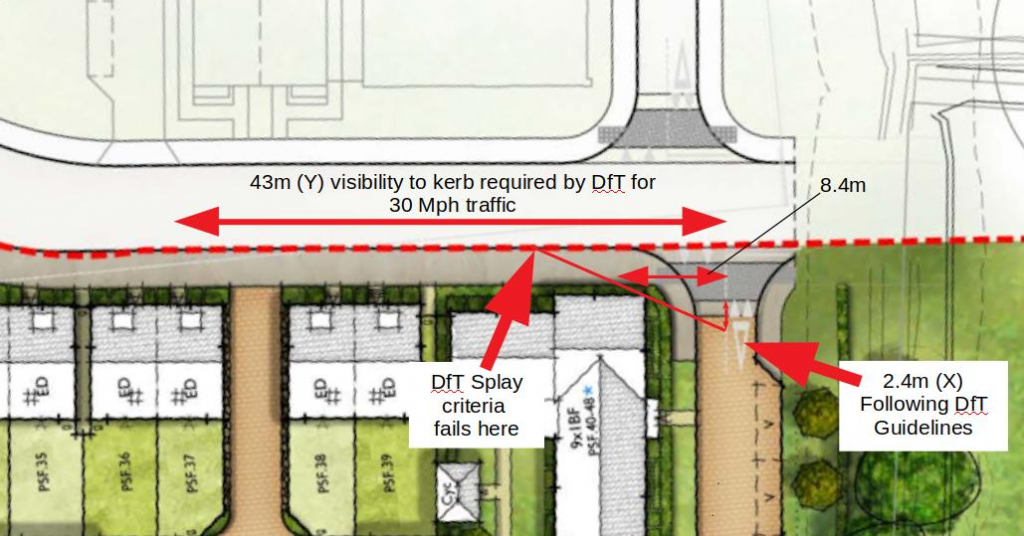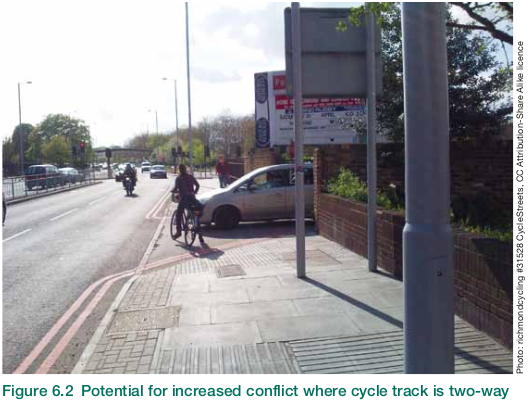Safety concerns over the West of Chichester development plans 20-01046-REM parcel 5F
ChiCycle have safety concerns over the West of Chichester development plans 20-01046-REM parcel 5F
Although we believe DfT minimum standards are not achieved for cyclists at any location on this development’s spine road, there are particular concerns over the new junctions presented in this application which have not been shown on previous plans. Not only is visibility of cyclists crossing side roads inadequate but it appears DfT visibility criteria for motor-vehicles are not achieved either.
Splay Analysis
Splay analysis shows whether road users have adequate visibility to proceed safely. Details can be found in section 7 of the DfT Manual for Streets.
Some problems arises because the mouths of junctions have geometry that differ from the previous planning agreement made under 18/01587/REM.
The junction shown below has the speed table set about a metre further back into the mouth of the junction than previously agreed.

The developers note that front garden planting will remain permanently below 600mm in height. ChiCycle campaigners feel it is unlikely this restriction could be successfully enforced. If any front garden plants grow taller there will be even greater visibility issues.
The junction analysis below is for a side road not previously shown on the agreed spine road plans 18/01587/REM.

If cars are intended to give way to cyclists, splay lines should start 2.4 meters from the edge of the path as is shown.
Assuming the front garden planting remains permanently lower than 600mm, the forward visibility of cyclists is less than 9 meters. DfT guidelines suggest this will only be safe if cycle speeds remain below 10 Mph. However, the DfT also state that commuter cyclists will want to continuously travel between 12 and 20 Mph.
The visibility of vehicles in the carriageway is shown to be only half that required for a junction onto a road with a 30 Mph restriction.
Another junction that was not included in the outline planning has even worse viability issues as can be seen in the analysis below.

Forward visibility of the carriageway from this junction gives a Y distance of only 15 metres. According to DfT this is only adequate if the traffic speed on the spine road is 15 Mph or below. Forward visibility of cyclists would only be satisfactory if their speeds remain below 10 Mph.
Cycle Routes Frequently Crossing Side Roads are Not Recommended
ChiCycle have noted the DfT advice given in Local Transport Note 1/12 (6.13) and cannot follow why it has been considered acceptable to route cyclists along a single pavement where recommendations state this solution is unsuitable if there are frequent side roads joining the carriageway:
Where cycle tracks alongside roads accommodate two-way flow, the potential for conflict can increase significantly. It is probable that drivers are less likely to expect cyclists to come from both directions because, intuitively, they might assume cyclists would be travelling in the same directions as traffic in the adjacent part of the carriageway – see Figures 6.1 and 6.2.
ChiCycle have also noted that both Local Transport Note 1/12 and Cycle infrastructure design (LTN 2/08) strongly recommend providing a cycleway in the carriageway rather than on pavements it this is at all feasible. The use of shared pavements is particularly discouraged where there are frequent side roads joining the carriageway.
DfT Manual For Streets (Page 71) states:
6.2.4
Cyclists are more likely to choose routes
that enable them to keep moving. Routes that take
cyclists away from their desire lines and require
them to concede priority to side-road traffic are
less likely to be used. Anecdotal evidence suggests
that cyclists using cycle tracks running adjacent
and parallel to a main road are particularly
vulnerable when they cross the mouths of side
roads and that, overall, these routes can be
more hazardous to cyclists than the equivalent
on-road route.
It is worth noting that the entire pavement along the Northern Spine Road fails to meet DfT minimum standards for shared paths as it is bound by vertical features such as the kerb that require additional width Cycle infrastructure design (LTN 2/08) section 8.5 and Local Transport Note 1/12 (7.28). In some places the effective width is only half of the recommended minimum which seems likely to endanger the safety all path users.
The scaled illustration below shows the issues associated with the cycleway width being restricted at side junctions and the cycleway swerving into the mouth of side road junctions.

Please contact your district or county councillors to bring these safety issues to their attention. It may also be worthwhile writing to the local press.
We are sure everyone reading this wants to ensure everyone in the Chichester area can enjoy Safe & Confident Cycling. Please help us campaign to make this a reality in new housing developments.
Mark Record


One thought on “Safety concerns over the West of Chichester development plans 20-01046-REM parcel 5F”